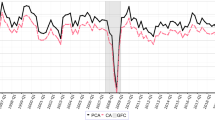Abstract
The family of classical interregional input-output models associated with authors such as Isard, Chenery, Moses, Leontief, Strout, Riefler and Tiebout may be classified and compared in terms of the assumed structure of their corresponding matrix of interregional trade share coefficients. In this way, a general hierarchy of interregional trade theories may be specified in terms of the quantity and nature of the trade data so assumed or collected. Each theoretical model reduces to a statistical estimation problem based on varying degrees of available trade information, and may therefore be handled conveniently using methods of statistical inference such as the principle of minimum information gain. By simply specifying any theoretical trade hypothesis in the form of a priori restrictions or linear constraints on the trade share estimates, this methodological principle can fruitfully be used to quantify and compare all the classical interregional models as well as other semisurvey approaches.
Similar content being viewed by others
References
Armington, P. S. “A Theory of Demand for Products Distinguished by Place of Production,”International Monetary Fund, Staff Papers, Vol. 16 (1969), pp. 159–176.
Batten, D. F. “The Interregional Linkages between National and Regional Input-Output Models,”International Regional Science Review, Vol. 7 (1982), pp. 53–67.
Batten, D. F.Spatial Analysis of Interacting Economies, Boston: Kluwer-Nijhoff, 1983.
Batten, D. F. “A Unifying Framework for Location-Production-Interaction Modelling,” Geoforum, Vol. 15 (1984), pp. 231–242.
Batten, D. F. and B. Johansson, “Price Adjustments and Multiregional Rigidities in the Analysis of World Trade,” Papers, Regional Science Association, Vol. 56 (1985).
Batten, D. F. “Modelling Interregional and International Trade Using Information Theory,”Chiikigaku-Kenkyu (Japanese Papers in Regional Science), Vol. 13 (1984), pp. 171–182.
Batten, D. F. and C. J. Tremelling, “The Estimation of Interregional Input-Output Tables for Victoria,”Papers, Australia-New Zealand Section of the Regional Science Association, Vol. 5 (1980), pp. 141–149.
Chenery, H., P. G. Clark and V. Cao Pinna,The Structure and Growth of the Italian Economy, Rome: U.S. Mutual Security Agency, 1953.
Isard, W. “Interregional and Regional Input-Output Analysis: A Model of a Space Economy,The Review of Economics and Statistics, Vol. 33 (1951), pp. 318–328.
Jaynes, E. T. “Information Theory and Statistical Mechanics,”Physical Review, Vol. 106 (1957), pp. 620–630.
Jaynes, E. T. “Prior Probabilities,”IEEE Transactions on Systems Science and Cybernetics, Vol. SSC-4 (1968), pp. 227–241.
Kadas, S. A. and E. Klafsky, “Estimation of the Parameters in the Gravity Model for Trip Distribution: A New Method and Solution Algorithm,”Regional Science and Urban Economics, Vol. 6 (1976), pp. 439–457.
Leontief, W. “Interregional Theory,” in W. Leontief (editor)Studies in the Structure of the American Economy, New York: Oxford University Press, 1953.
Leontief, W. and A. Strout, “Multiregional Input-Output Analysis,” in T. Barna (editor),Structural Interdependence and Economic Development, London: MacMillan, 1963.
Leontief, W., A. Carter and P. Petri,The Future of the World Economy, New York: Oxford University Press, 1977.
Martellato, D., “La disparita multiregionale come equilibrio non walrasiano,” in G. Bianchi, I. Magnani (editors),Sviluppo multiregionale: teorie, metodi, problemi, Milano: Franco Angeli, 1984.
Miernyk, W. H., “Regional and Interregional Input-Output Models: A Reappraisal” in N. Perlman, C. Leven and B. Chinitz (editors),Spatial, Regional and Population Economies, New York: Gordon and Breach, 1973.
Moses, L. N., “The Stability of Interregional Trading Patterns and Input-Output Analysis,American Economic Review, Vol. 45 (1955), pp. 803–832.
Ohlin, B. G.,Interregional and International Trade, Massachusetts: Harvard University Press, 1933.
Riefler, R., “Interregional Input-Output: A State of the Arts Survey,” in G. G. Judge and T. Takayama (editors),Studies in Economic Planning Over Space and Time, Amsterdam: North-Holland, 1973.
Riefler, R. and C. M. Tiebout, “Interregional Input-Output: An Empirical California-Washington Model,”Journal of Regional Science, Vol. 10 (1970), pp. 135–152.
Snickars, F. and J. W. Weibull, “A Minimum Information Principle: Theory and Practice,”Regional Science and Urban Economics, Vol. 7 (1977), pp. 137–168.
Webber, M. J.,Information Theory and Urban Spatial Structure, London: Croom Helm, 1979.
Author information
Authors and Affiliations
Rights and permissions
About this article
Cite this article
Batten, D., Martellato, D. Classical versus modern approaches to interregional input-output analysis. Ann Reg Sci 19, 1–15 (1985). https://doi.org/10.1007/BF01294827
Received:
Revised:
Issue Date:
DOI: https://doi.org/10.1007/BF01294827




